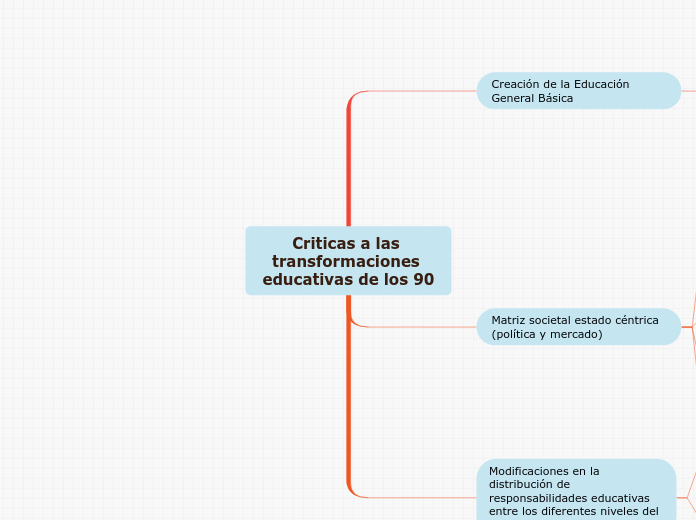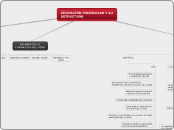Criticas a las transformaciones educativas de los 90
To name your story, you have to think about the overall message and what you want your audience to understand from the story. Also, make it relevant and easy to remember.
Modificaciones en la distribución de responsabilidades educativas entre los diferentes niveles del Estado.
The ending of a story is essential. We all know that if the ending is weak, what happened before loses its importance. So make it unpredictable, but fair. A resolved ending answers all the questions and ties up any loose threads from the plot.
Las jurisdicciones pasaron a tener la responsabilidad sobre la gestion de las instituciones ubicadas en su territorio
This is the closure section of the story.
See examples of possible outcomes below:
- all problems have been solved
- it's clear how each one of your characters ends up
- your main character is transformed by the challenge
El estado transfiere recursos para la construccion y afianzamiento del poder de los caudillos
Controlar el conflicto con los gremios
Try answering these questions to come up with a closure:
- Have all the problems been solved?
- Is there a clear picture of what happens with each character in the story?
- Has the challenge transformed your main character?
- How do the characters feel in the end?
Mayores responsabilidades en los niveles intermedios
This is the moment when the main character surpasses the last obstacle and finally faces their greatest challenge.
The climax usually follows one of these patterns:
- realization
- resolution
- choice
Type in your answer.
Matriz societal estado céntrica (política y mercado)
The middle of the story is where you add layers of complications that will lead to the end. Reveal more about the character's journey. Did their personality go through changes? How did they overcome the challenges? And as you build up the story’s central conflict, make it more personal to that character. Also, from the middle act, you have to lead into the final act.
Administración por proyectos
Los recursos pasaron a depender de la capacidad de la escuela para transformar demandas en proyectos
El mensaje dejo de ser "a cada institución según su necesidad" y paso a ser "a cada uno según su capacidad de competir.
Tarea asistencial del Estado
There wouldn't be any tension and excitement in your story if there weren't any obstacles in your character's way.
Se transformo a las políticas educativas en políticas para pobres
A story is nothing more than a character overcoming a series of difficulties to reach the desired goal. Obstacles usually create suspense and conflict. In overcoming obstacles, there is growth: weak becomes strong; hatred turns into love; sadness into happiness; wrong into right; lies into truth; or evil becomes good.
See a few examples below:
- stopping a meteor
- finding a killer
- finding love
Los sectores medios se pasaron a la educación privada
Generar "eficiencia en los recursos" (políticas neo-liberales". Para generar mayor equidad.
Your character(s) need(s) motivation in order to solve the challenge(s).
Proceso de desentralizacion del Estado
Secondary characters might also have motives that lead them to cross paths with the main character or which might trigger them to help the main character.
Cambio regresivo en la estructura social
Why does your character need to confront this challenge? What does he/she expect to accomplish by solving it?
See a few examples:
- will marry in 3 days
- can fix the mistakes of the past
reversión de la dinámica a favor del movimiento de descenso social de clases medias y bajas.
Otorgo a la política una decisiva centralidad en la definición de criterios y construcción de redes para regular, controlar y administrar la sociedad.
Each story has a main character and that character usually needs to solve a problem or challenge. The character's challenge is the one that creates tension throughout the story.
Creación de la Educación General Básica
In the beginning of the story (or the exposition), you will need to introduce the setting and characters. You might also want to introduce the main conflict. This part of the story is important because it gives the reader necessary background information and maybe even a first insight into a character’s personality.
Dividida en tres ciclos
Characters are essential to a good story. Usually, the protagonist(s) is/are the most affected by the plot. Introduce a character by focusing on their actions, interests, and occupation, as the physical appearance doesn't make a difference in most cases.
Se extiende la obligatoriedad a 10 años
Type in the name of your character.
Mayor incorporación de los sectores populares a los últimos años de la EGB
Add other qualities/attributes of the character.
Caos en el sistema. No todas las jurisdicciones procedieron a la modificación, otras hicieron sus propias reformas.
What is your character's main goal?
fight Evilfind lovedefeat his/her enemyrule the worldmake friendstime travelmake an awesome discoveryOther
No todas las jurisdicciones procedieron a la modificación, otras hicieron sus propias reformas. Se generaron mas de treinta estructuras organizacionales.
Adopción de propuestas acríticamente, sin considerar la situación educativa del país
Which traits best describe the character's personality? Choose more if necessary:
introvertedloyalkindindependentquick-thinkingadventuresomeidealisticsweet-naturedcalmrisk-takercreativewittystrictfussyweirdclumsyharshaggressivecarelessclingingcowardlycrueldeceitfulimpulsiveOther
Propósito de aumentar dos años la escolaridad, sin abrir a la masa de la población el acceso a la educación secundaria.
Choose the type of your chacter:
Protagonist (main character)Antagonist (main character's opponent)Flat (stereotypical character)Round (his/ her personality develops throughout the story)Static (doesn't evolve as a person throughout the story)Dynamic (dramatical change in personality)Confidant (the main character trusts him/ her)Foil (contrasting character who enhances the personality of another character)Other










